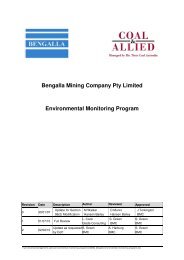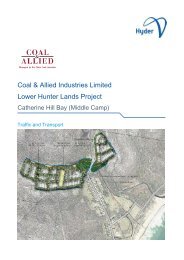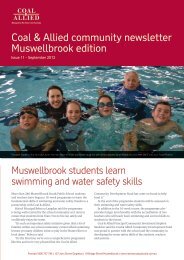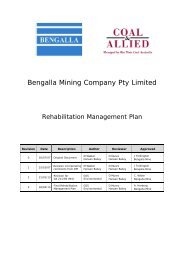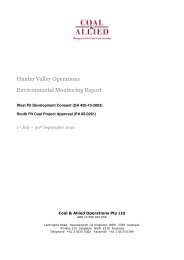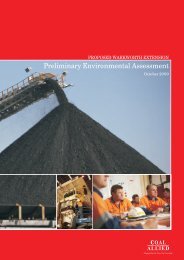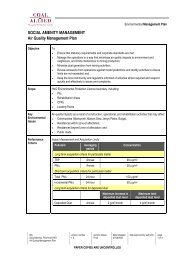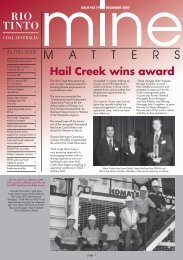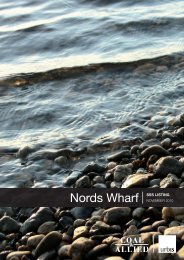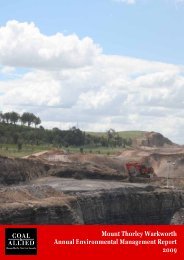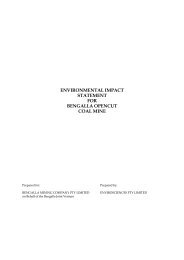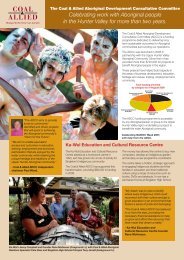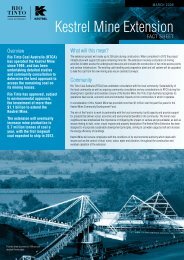HVO 2009 Annual Environmental Management Report - Final
HVO 2009 Annual Environmental Management Report - Final
HVO 2009 Annual Environmental Management Report - Final
Create successful ePaper yourself
Turn your PDF publications into a flip-book with our unique Google optimized e-Paper software.
Coal & Allied – Hunter Valley Operations<br />
<br />
Protective management measures such as fencing/barricading sites to avoid disturbance, protective<br />
buffer zones, cultural heritage off-set areas; and<br />
Communicating cultural heritage issues and site awareness to personnel via the Coal & Allied intranet<br />
and tool box training sessions.<br />
The CHMS GIS, CHZP, EMS <strong>Environmental</strong> Procedure 2.1 Cultural Heritage <strong>Management</strong>, EMS<br />
<strong>Environmental</strong> Procedure 13.3 Ground Disturbance Permit and LODB requirements are the key operational<br />
and planning tools utilised to protect and manage Aboriginal cultural heritage at <strong>HVO</strong>. A GDP permit must be<br />
obtained prior to the commencement of any disturbance of Coal & Allied land outside current mining<br />
operations. All cultural heritage approvals and conditions are assessed and authorised by Rio Tinto Coal<br />
Australia Aboriginal Relations, Brisbane. The GDP permit and Limit of Disturbance Boundary alert personnel<br />
to the general location of cultural heritage sites in the vicinity of operations and provides clarity on the extent<br />
and boundary of approved work areas to personnel conducting ground disturbing activities.<br />
Operational compliance with GDP requirements for the protection of Aboriginal cultural heritage is internally<br />
audited under the CHMS procedures by Rio Tinto Coal Australia Aboriginal Relations and through external<br />
auditing processes associated with the <strong>HVO</strong> EMS requirements and Rio Tinto Cultural Heritage <strong>Management</strong><br />
Standard audit protocols. Staff from Rio Tinto Coal Australia Aboriginal Relations and <strong>HVO</strong> environmental<br />
personnel, conduct pre and post-construction GDP work area inspections to ensure compliance with GDP<br />
approvals and conditions. In <strong>2009</strong> a total of 43 GDP’s at were assessed at <strong>HVO</strong> along with regular targeted<br />
work area inspections carried out as part of the routine CHMS risk management procedures.<br />
Where mining or associated activities will significantly affect Aboriginal cultural heritage, an appropriate<br />
consent and / or permit is sought from the DECCW under sections 87/90 of the NPW Act. New major project<br />
developments are assessed under Part 3A of the EP&A Act which makes provision for Rio Tinto Coal<br />
Australia and Aboriginal parties to develop a Cultural Heritage <strong>Management</strong> Plan.<br />
On 24 March <strong>2009</strong> the Minister for Planning approved the <strong>HVO</strong> South Coal Project (PA_06_0261). The new<br />
approval encompasses all of the <strong>HVO</strong> mining development areas south of the Hunter River. <strong>HVO</strong> South PA<br />
06_0261, Schedule 3, Part 40 requires that the Coal & Allied prepares and implements an ‘Aboriginal<br />
Heritage <strong>Management</strong> Plan (AHMP)’ to be submitted and approved by the Director-General, DoP, within 12<br />
months of the date of the development approval and that the ‘Aboriginal Heritage <strong>Management</strong> Plan’ be<br />
prepared in consultation with DECCW and the Aboriginal community. A draft AHMP has been developed in<br />
consultation with DECCW and the CHWG and was submitted to DoP in May <strong>2009</strong> for review and approval.<br />
<strong>HVO</strong> mining development activities located north of the Hunter River are regulated under DA-450-10-2003<br />
which consolidated a number of previous development consents for mining operations. Cultural heritage<br />
management requirements are outlined in Schedule 4, conditions 37 to 41A of DA-450-10-2003. Condition 40<br />
requires that the provisions of the Cultural Heritage Indigenous <strong>Management</strong> Agreement (CHIMA), approved<br />
in August 2002 under superseded DA 106-6-99, continue in application for the Carrington Mine area.<br />
During <strong>2009</strong> DECCW granted Aboriginal Heritage Impact Permit (AHIP) s90 consent #1102084 for cultural<br />
salvage of a number of Aboriginal heritage sites associated with the <strong>HVO</strong> Riverview Pit. DECCW also granted<br />
a variation to AHIP care and control permit #2863 to include cultural artefacts salvaged under AHIP<br />
#1102084. Care and control permit #2863 consolidates authorities for Coal & Allied to take custody of cultural<br />
artefacts salvaged under AHIP consents 1708, 1795, 1870, 2086, 2233, 2488, 2491, 2547, 3147, 2906 and<br />
1102084. The duration of Care and Control permit #2863 was also extended to January 2013, to further<br />
facilitate negotiations between Rio Tinto Coal Australia and the Aboriginal community in the Upper Hunter<br />
Valley in regards to long term custodial arrangements for the Aboriginal cultural material.<br />
AEMR <strong>2009</strong> 140



